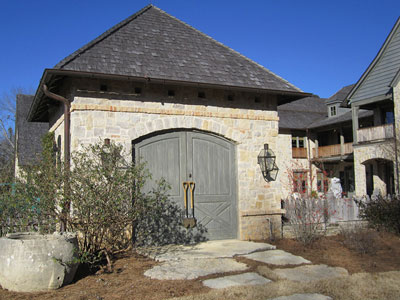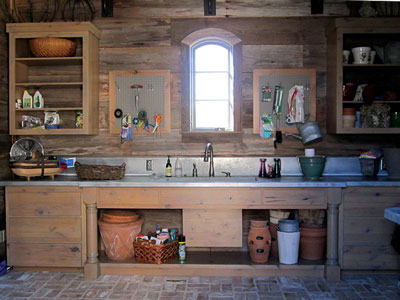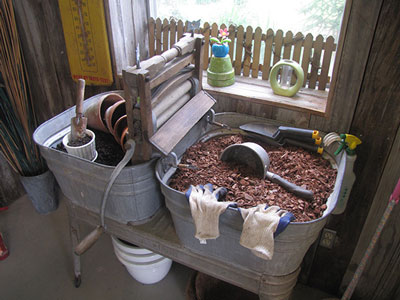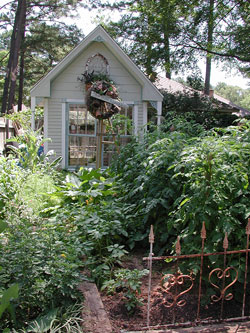From the Magazine: October 2014

This lovely pigeonnier-styled shed echoes the dovecotes of France and coordinates with the style of the Texas home it adjoins. All photos by Mary Wilhite.
by Mary Wilhite
Great Garden Sheds
There is one for every gardener’s taste and tools
Every gardener longs for a garden shed – a place to store tools, empty pots, seeds, potting soil and fertilizers. But after working to create beauty in your yard, you don’t want just a portable building plunked into the corner. You desire an attractive building that complements your landscape while it functions as the repository of your garden junk. I would like to tour you around two different approaches to this need: a new building constructed in the same style as the nearby home (photos next page) and a recycled metal building lovingly rescued and repurposed.
The Pigeonnier
When a Dallas couple decided to build a weekend house on their ranch property in East Texas in 2010, the wife knew she wanted a garden shed built on the same space. Their architect suggested building it in the style of a French pigeonnier to match the design of their new home. A pigeonnier, known as a dovecote in English, is a structure designed to house pigeons or doves and has holes or small alcoves high on the walls for the birds to nest.

Inside the pigeonnier potting shed, a large zinc sink and ample cupboards stand ready for all kinds of potting and gardening chores.
The homeowner is an avid gardener, and she desired a space for her many garden projects. The building has large windows to light the interior naturally and large doors that can be opened to catch a breeze. The thick stone walls keep the space cool even in the heat of summer, and the brick floor is easy to clean. A large zinc sink is built into a wall of cabinets, perfect for flower arranging. Large bins salvaged from an old hardware store hold tools, pots, bird feeders and bird feed in perfect order, yet easy to access.
The exterior of the building shows the same attention to detail. Black shutters bracket the windows, mimicking the look of the adjacent house. A gorgeous Don Juan rose clambers up the corner and clings to two walls, softening the hard stone. Handles on the large doors are crafted from shovels. The result is charming as well as totally functional.
A Repurposed Carport
For 20 years Debbie and Brad Edwards have worked to create a wooded, serene environment on their large lot. What was once a pasture around their house is now a garden paradise. When Brad’s sister offered them her metal building (designed to cover an RV) with an attached storage building, Debbie saw it as the perfect opportunity to make the garden shed she had always dreamed about.
Brad disassembled the building, poured a concrete slab for it behind their pool, and rebuilt the tall structure. In the storeroom that Debbie designated as her future potting shed, he cut new, large windows to let in the sunlight. Then Debbie got to work decorating her space with collected treasures and family memorabilia. Against one wall is a church pew from Brad’s mother’s church. Displayed on the pew are music instruments from Debbie’s dad’s music store, now painted in bright colors and bestowed with humorous names. “Tooty Flutey” is Debbie’s flute from her high school band days. On the wall hang her grandmother’s hand tools and a mosaic salamander crafted by an aunt. An old double wringer wash basin purchased by her dad is repurposed into the potting spot.

Beneath a large window that was added for light in the carport, an old double-tub wringer washer takes on new life as a potting station.
The shed isn’t just a quaint retreat or a museum of family relics; it is functional as well. Debbie’s mom, Ann, lives with them now and shares their love of plants and nature. She has a corner in the shed lined with shelves to store birdseed and food for the koi that swim lazily through her water feature. Tools are hung neatly on the wall or contained in an old milk bucket. Cupboards hold pots, seeds and vases.
But Debbie wanted her garden shed to be as attractive as the grounds surrounding it, so she has added homey touches. Curtains hang on the windows. An outdoor rug sits under the brightly painted metal table and chairs at the center of the room, and garden-related items decorate the walls and shelves. It makes her space a relaxing personal getaway as well.
Upgrade your shack to a stylish shed

A small “herb shed” becomes a charming focal point in this lush summer garden.
You don’t have to invest a lot of money in constructing a fancy new building for your garden shed. A playhouse abandoned by growing children can be refitted for the purpose. A metal building can be painted and decorated to make it harmonize with the landscape without being an eyesore. With a little planning and work, you, too, can have a functional, attractive garden shed for your use and pleasure.
Here are some ideas to help you turn a utilitarian shack into a charming garden shed.
Outside
- Add large windows and doors for light and ventilation.
- Build a covered porch or a patio onto the structure.
- Add trim (window shutters or planted window boxes), fixtures (lights, hinges and door handles), and accents (trellises, sculpture).
- Paint the exterior walls. Use at least two different colors for walls and trim.
- Plant gardens around the building to make it part of the landscape.
Inside
- Install shelving, cabinets, tool hangers and bins for tidy organization.
- Add personal touches, and decorate as you would inside your house.
- Have the building plumbed and wired. Water is useful for potting and cleaning up, and electricity is nice for lighting, heating and cooling.
